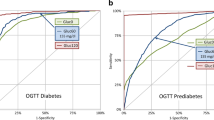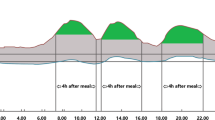Abstract
Objective:
Type 2 diabetes (T2DM) is known to be underdiagnosed. Tests for diagnosis include fasting plasma glucose (FPG), oral glucose tolerance test (OGTT) and HbA1c. HbA1c can be tested in non-fasting conditions. Therefore, general practitioners almost no longer execute OGTT’s. We evaluated the performance of OGTT versus HbA1c in a population consisting of overweight and obese subjects, which can be considered a ‘high risk’ population.
Research design and methods:
A total of, 1241 overweight and obese subjects without a history of diabetes (male/female: 375/866, age 44±13 years, body mass index 38.0±6.1 kg m−2) were tested for glucose tolerance status using FPG, OGTT and HbA1c.
Results:
Exactly, 46.8% were found to have prediabetes and 11.9% were newly diagnosed with T2DM (male/female=18.9/8.9%) using ADA criteria. Testing only HbA1c would have resulted in 78 subjects being diagnosed with T2DM, but 47.3% of newly diagnosed patients would have been missed if OGTT would not have been done. Exactly 581 subjects were diagnosed with prediabetes, 1.4% subjects had impaired fasting glucose (IFG) 30.5% had impaired glucose tolerance (IGT), 5.1% subjects had a combined IFG+IGT, and 9.8% had an isolated elevated HbA1c (5.7–6.4%). Of the 581 subjects with prediabetes, 257 had an HbA1c <5.7%. Therefore, 44.2% subjects would have been missed when OGTT would not have been done.
Conclusion:
In a population with only overweight and obese adult subjects, 46.8% were diagnosed with prediabetes and 11.9% were newly diagnosed with diabetes. Exactly, 5.6 and 20.7% of total population met the diagnostic criteria of the OGTT for diabetes and prediabetes, respectively, but did not meet the diagnostic criteria of the HbA1c. These data suggest that not performing an OGTT results in significant underdiagnose of T2DM in an overweight and obese adult population.
This is a preview of subscription content, access via your institution
Access options
Subscribe to this journal
Receive 12 print issues and online access
$259.00 per year
only $21.58 per issue
Buy this article
- Purchase on Springer Link
- Instant access to full article PDF
Prices may be subject to local taxes which are calculated during checkout
Similar content being viewed by others
References
International Diabetes Federation (IDF). IDF Diabetes Atlas 7th edition [Internet]. idf.org. 2015. Available from http://www.diabetesatlas.org/.
Gregg EW, Cadwell BL, Cheng YJ, Cowie CC, Williams DE, Geiss L et al. Trends in the prevalence and ratio of diagnosed to undiagnosed diabetes according to obesity levels in the U.S. Diabetes Care 2004; 27: 2806–2812.
Wild S, Roglic G, Green A, Sicree R, King H . Global prevalence of diabetes: estimates for the year 2000 and projections for 2030. Diabetes Care 2004; 27: 1047–1053.
Tabák AG, Herder C, Rathmann W, Brunner EJ, Kivimäki M . Prediabetes: a high-risk state for diabetes development. Lancet 2012; 379: 2279–2290.
International Expert Committee. International expert committee report on the role of the A1C assay in the diagnosis of diabetes. Diabetes Care 2009; 32: 1327–1334.
van Leiden Ha, Dekker JM, Moll AC, Nijpels G, Heine RJ, Bouter LM et al. Risk factors for incident retinopathy in a diabetic and nondiabetic population: the Hoorn study. Arch Ophthalmol 2003; 121: 245–251.
Tapp RJ, Tikellis G, Wong TY, Harper CA, Zimmet PZ, Shaw JE . Longitudinal association of glucose metabolism with retinopathy. Diabetes Care 2008; 31: 1349–1354.
Wong TY, Liew G, Tapp RJ, Schmidt MI, Wang JJ, Mitchell P et al. Relation between fasting glucose and retinopathy for diagnosis of diabetes: three population-based cross-sectional studies. Lancet 2008; 371: 736–743.
ADA. Classification and Diagnosis of Diabetes. Diabetes Care 2016; 39: 13–22.
Saukkonen T, Cederberg H, Jokelainen J, Laakso M, Härkönen P, Keinänen-Kiukaanniemi S et al. Limited overlap between intermediate hyperglycemia as defined by A1C 5.7-6.4%, impaired fasting glucose, and impaired glucose tolerance. Diabetes Care 2011; 34: 2314–2316.
Fizelova M, Stančáková A, Lorenzo C, Haffner SM, Cederberg H, Kuusisto J et al. Glycated hemoglobin levels are mostly dependent on nonglycemic parameters in 9398 Finnish men without diabetes. J Clin Endocrinol Metab 2015; 100: 1989–1996.
Guo F, Moellering DR, Garvey WT . Use of HbA1c for diagnoses of diabetes and prediabetes: comparison with diagnoses based on fasting and 2-Hr glucose values and effects of gender, race, and age. Metab Syndr Relat Disord 2014; 12: 258–268.
Lorenzo C, Wagenknecht LE, Hanley AJG, Rewers MJ, Karter AJ, Haffner SM . A1C between 5.7 and 6.4% as a marker for identifying pre-diabetes, insulin sensitivity and secretion, and cardiovascular risk factors: the Insulin Resistance Atherosclerosis Study (IRAS). Diabetes Care 2010; 33: 2104–2109.
Cowie CC, Rust KF, Byrd-Holt DD, Gregg EW, Ford ES, Geiss LS et al. Prevalence of diabetes and high risk for diabetes using A1C criteria in the U.S. population in 1988-2006. Diabetes Care 2010; 33: 562–568.
Diabetes Prevention Program Research Group. HbA 1c as a predictor of diabetes and as an outcome in the diabetes prevention program: a randomized clinical trial. Diabetes Care 2015; 38: 51–58.
NCD Risk Factor Collaboration. Effects of diabetes definition on global surveillance of diabetes prevalence and diagnosis: a pooled analysis of 96 population-based studies with 331 288 participants. Lancet Diabetes Endocrinol 2015; 8587: 1–14.
van der Kooy K, Seidell JC . Techniques for the measurement of visceral fat: a practical guide. Int J Obes Relat Metab Disord 1993; 17: 187–196.
Kvist H, Chowdhury B, Grangard U, Tylen U, Sjostrom L . Total and visceral adipose-tissue volumes derived from measurements with computed tomography in adult men and women: Predictive equations. Am J Clin Nutr 1988; 48: 1351–1361.
Matthews DR, Hosker JP, Rudenski AS, Naylor BA, Treacher DF, Turner RC . Homeostasis model assessment insulin resistance and beta-cell function from fasting plasma glucose and insulin concentrations in man. Diabetologia 1985; 28: 412–419.
Meijnikman AS, De Block CEM, Verrijken A, Mertens I, Corthouts B, Van Gaal LF . Screening for type 2 diabetes mellitus in overweight and obese subjects made easy by the FINDRISC score. J Diabetes Complicat 2016; 30: 1043–1049.
Rathmann W, Kowall B, Tamayo T, Giani G, Holle R, Thorand B et al. Hemoglobin A1c and glucose criteria identify different subjects as having type 2 diabetes in middle-aged and older populations: the KORA S4/F4 Study. Ann Med 2012; 44: 170–177.
Li J, Ma H, Na L, Jiang S, Lv L, Li G et al. Increased hemoglobin A1c threshold for prediabetes remarkably improving the agreement between A1c and oral glucose tolerance test criteria in obese population. J Clin Endocrinol Metab 2015; 100: 1997–2005.
Tabak AG, Jokela M, Akbaraly TN, Brunner EJ, Kivimaki M, Witte DR . Trajectories of glycaemia, insulin sensitivity, and insulin secretion before diagnosis of type 2 diabetes: an analysis from the Whitehall II study. Lancet 2009; 373: 2215–2221.
Stancáková A, Javorsky M, Kuulasmaa T, Haffner SM, Kuusisto J, Stančáková A et al. Changes in Insulin Sensitivity and Insulin Release in Relation to Glycemia and Glucose Tolerance in 6,414 Finnish Men. Diabetes 2009; 58: 1212–1221.
Heianza Y, Arase Y, Fujihara K, Tsuji H, Saito K, Hsieh SD et al. High normal HbA1c levels were associated with impaired insulin secretion without escalating insulin resistance in Japanese individuals: The Toranomon Hospital Health Management Center Study 8 (TOPICS 8). Diabetes Med 2012; 29: 1285–1290.
Borai A, Livingstone C, Abdelaal F, Bawazeer A, Keti V, Ferns G . The relationship between glycosylated haemoglobin (HbA1c) and measures of insulin resistance across a range of glucose tolerance. Scand J Clin Lab Invest 2011; 71: 168–172.
Kanat M, Winnier D, Norton L, Arar N, Jenkinson C, Defronzo RA et al. The relationship between β-cell function and glycated hemoglobin: Results from the veterans administration genetic epidemiology study. Diabetes Care 2011; 34: 1006–1010.
Ryden L, Grant PJ, Anker SD, Berne C, Cosentino F, Danchin N et al. ESC guidelines on diabetes, pre-diabetes, and cardiovascular diseases developed in collaboration with the EASD. Eur Heart J 2013; 34: 3035–3087.
Menke A, Rust KF, Savage PJ, Cowie CC . Hemoglobin A1c, fasting plasma glucose, and 2-hour plasma glucose distributions in U.S. population subgroups: NHANES 2005-2010. Ann Epidemiol 2014; 24: 83–89.
Acknowledgements
We thank the nursing staff and all patients for making this observational study possible. The results of this study were presented in part at the 75th Scientific Sessions of the ADA (American Diabetes Association), Boston, USA, June 2015.
Author contributions
All authors made important intellectual contributions to the conception and design of the study. Every author reviewed and provided comments on manuscript drafts and gave final approval of this version to be published. CEMDB and LFVG were responsible for the final design of the protocol. LFVG recruited patients and was responsible for the database. All authors implemented the study protocol and acquired data. ASM, CEMDB, IM and AV performed the statistical analysis. ASM, ED and CEMDB drafted the manuscript.
Author information
Authors and Affiliations
Corresponding author
Ethics declarations
Competing interests
The authors declare no conflict of interest.
Rights and permissions
About this article
Cite this article
Meijnikman, A., De Block, C., Dirinck, E. et al. Not performing an OGTT results in significant underdiagnosis of (pre)diabetes in a high risk adult Caucasian population. Int J Obes 41, 1615–1620 (2017). https://doi.org/10.1038/ijo.2017.165
Received:
Revised:
Accepted:
Published:
Issue Date:
DOI: https://doi.org/10.1038/ijo.2017.165
This article is cited by
-
Association between the triglyceride-glucose index and impaired cardiovascular fitness in non-diabetic young population
Cardiovascular Diabetology (2024)
-
Relationship between BMI and risk of impaired glucose tolerance and impaired fasting glucose in Chinese adults: a prospective study
BMC Public Health (2023)
-
Pre-transplant HbA1c and risk of diabetes mellitus after kidney transplantation: a single center retrospective analysis
Journal of Nephrology (2023)
-
Oral glucose tolerance testing at 1 h and 2 h: relationship with glucose and cardiometabolic parameters and agreement for pre-diabetes diagnosis in patients with morbid obesity
Diabetology & Metabolic Syndrome (2022)
-
Recent Developments in Biomarkers for Diagnosis and Screening of Type 2 Diabetes Mellitus
Current Diabetes Reports (2022)



